Lab 8: Object recognition with convolutional neural networks#
In this lab we consider the CIFAR dataset, but model it using convolutional neural networks instead of linear models. There is no separate tutorial, but you can find lots of examples in the lecture notebook on convolutional neural networks.
Tip: You can run these exercises faster on a GPU (but they will also run fine on a CPU). If you do not have a GPU locally, you can upload this notebook to Google Colab. You can enable GPU support at “runtime” -> “change runtime type”.
import tensorflow as tf
import os
tf.config.experimental.list_physical_devices('GPU') # Check whether GPUs are available
os.environ['TF_CPP_MIN_LOG_LEVEL'] = "2"
%matplotlib inline
import openml as oml
import matplotlib.pyplot as plt
# Download CIFAR data. Takes a while the first time.
# This version returns 3x32x32 resolution images.
# If you feel like it, repeat the exercises with the 96x96x3 resolution version by using ID 41103
cifar = oml.datasets.get_dataset(40926)
X, y, _, _ = cifar.get_data(target=cifar.default_target_attribute, dataset_format='array');
cifar_classes = {0: "airplane", 1: "automobile", 2: "bird", 3: "cat", 4: "deer",
5: "dog", 6: "frog", 7: "horse", 8: "ship", 9: "truck"}
# The data is in a weird 3x32x32 format, we need to reshape and transpose
Xr = X.reshape((len(X),3,32,32)).transpose(0,2,3,1)
# Take some random examples, reshape to a 32x32 image and plot
from random import randint
fig, axes = plt.subplots(1, 5, figsize=(10, 5))
for i in range(5):
n = randint(0,len(Xr))
# The data is stored in a 3x32x32 format, so we need to transpose it
axes[i].imshow(Xr[n]/255)
axes[i].set_xlabel((cifar_classes[int(y[n])]))
axes[i].set_xticks(()), axes[i].set_yticks(())
plt.show();

Exercise 1: A simple model#
Split the data into 80% training and 20% validation sets
Normalize the data to [0,1]
Build a ConvNet with 3 convolutional layers interspersed with MaxPooling layers, and one dense layer.
Use at least 32 filters in the first layer and ReLU activation.
Otherwise, make rational design choices or experiment a bit to see what works.
You should at least get 60% accuracy.
For training, you can try batch sizes of 64, and 20-50 epochs, but feel free to explore this as well
Plot and interpret the learning curves
from sklearn.model_selection import train_test_split
X_train, X_test, y_train, y_test = train_test_split(Xr,y, stratify=y, train_size=0.8)
from tensorflow.keras.utils import to_categorical
X_train = X_train / 255.
X_test = X_test / 255.
y_train = to_categorical(y_train)
y_test = to_categorical(y_test)
from tensorflow.keras import layers
from tensorflow.keras import models
model = models.Sequential()
model.add(layers.Conv2D(32, (3, 3), activation='relu', input_shape=(32, 32, 3)))
model.add(layers.MaxPooling2D((2, 2)))
model.add(layers.Conv2D(64, (3, 3), activation='relu'))
model.add(layers.MaxPooling2D((2, 2)))
model.add(layers.Conv2D(64, (3, 3), activation='relu'))
model.add(layers.Flatten())
model.add(layers.Dense(64, activation='relu'))
model.add(layers.Dense(10, activation='softmax'))
model.compile(optimizer='rmsprop',
loss='categorical_crossentropy',
metrics=['accuracy'])
history = model.fit(X_train, y_train, epochs=25, batch_size=64, verbose=0,
validation_data=(X_test, y_test))
Metal device set to: Apple M1 Pro
import pandas as pd
import numpy as np
pd.DataFrame(history.history).plot(lw=2,style=['b:','r:','b-','r-']);
print("Max val_acc",np.max(history.history['val_accuracy']))
Max val_acc 0.6492500305175781

Already decent performance but the model starts overfitting heavily after epoch 15.
Exercise 2: VGG-like model#
Mimic the VGG model by building 3 ‘blocks’ of 2 convolutional layers each
Do MaxPooling after each block
The first layer should have at least 32 filters
Use zero-padding to be able to build a deeper model
Use a dense layer with at least 128 hidden nodes.
Plot and interpret the learning curves
model = models.Sequential()
model.add(layers.Conv2D(32, (3, 3), activation='relu', padding='same', input_shape=(32, 32, 3)))
model.add(layers.Conv2D(32, (3, 3), activation='relu', padding='same'))
model.add(layers.MaxPooling2D((2, 2)))
model.add(layers.Conv2D(64, (3, 3), activation='relu', padding='same'))
model.add(layers.Conv2D(64, (3, 3), activation='relu', padding='same'))
model.add(layers.MaxPooling2D((2, 2)))
model.add(layers.Conv2D(128, (3, 3), activation='relu', padding='same'))
model.add(layers.Conv2D(128, (3, 3), activation='relu', padding='same'))
model.add(layers.MaxPooling2D((2, 2)))
model.add(layers.Flatten())
model.add(layers.Dense(128, activation='relu'))
model.add(layers.Dense(10, activation='softmax'))
model.compile(optimizer='rmsprop',
loss='categorical_crossentropy',
metrics=['accuracy'])
history = model.fit(X_train, y_train, epochs=25, batch_size=64, verbose=0,
validation_data=(X_test, y_test))
pd.DataFrame(history.history).plot(lw=2,style=['b:','r:','b-','r-']);
print("Max val_acc",np.max(history.history['val_accuracy']))
Max val_acc 0.6827500462532043
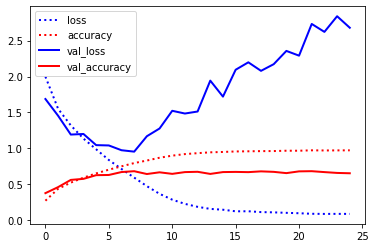
Better result, but still overfitting heavily
Exercise 3: Regularization#
Explore different ways to regularize your VGG-like model
Try adding some dropout after every MaxPooling and Dense layer.
What are good Dropout rates?
Try batch nornmalization together with Dropout
Plot and interpret the learning curves
model = models.Sequential()
model.add(layers.Conv2D(32, (3, 3), activation='relu', padding='same', input_shape=(32, 32, 3)))
model.add(layers.Conv2D(32, (3, 3), activation='relu', padding='same'))
model.add(layers.MaxPooling2D((2, 2)))
model.add(layers.Dropout(0.2))
model.add(layers.Conv2D(64, (3, 3), activation='relu', padding='same'))
model.add(layers.Conv2D(64, (3, 3), activation='relu', padding='same'))
model.add(layers.MaxPooling2D((2, 2)))
model.add(layers.Dropout(0.2))
model.add(layers.Conv2D(128, (3, 3), activation='relu', padding='same'))
model.add(layers.Conv2D(128, (3, 3), activation='relu', padding='same'))
model.add(layers.MaxPooling2D((2, 2)))
model.add(layers.Dropout(0.2))
model.add(layers.Flatten())
model.add(layers.Dense(128, activation='relu'))
model.add(layers.Dropout(0.2))
model.add(layers.Dense(10, activation='softmax'))
model.compile(optimizer='rmsprop',
loss='categorical_crossentropy',
metrics=['accuracy'])
history = model.fit(X_train, y_train, epochs=25, batch_size=64, verbose=0,
validation_data=(X_test, y_test))
pd.DataFrame(history.history).plot(lw=2,style=['b:','r:','b-','r-']);
print("Max val_acc",np.max(history.history['val_accuracy']))
Max val_acc 0.7305000424385071
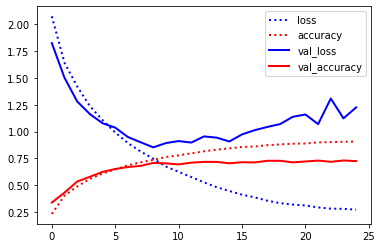
Accuracy is quite a bit better and overfitting seems lessened
Another common approach is to gradually increase the amount of dropout. This forces layers deep in the model to regularize more than layers closer to the input.
model = models.Sequential()
model.add(layers.Conv2D(32, (3, 3), activation='relu', padding='same', input_shape=(32, 32, 3)))
model.add(layers.Conv2D(32, (3, 3), activation='relu', padding='same'))
model.add(layers.MaxPooling2D((2, 2)))
model.add(layers.Dropout(0.2))
model.add(layers.Conv2D(64, (3, 3), activation='relu', padding='same'))
model.add(layers.Conv2D(64, (3, 3), activation='relu', padding='same'))
model.add(layers.MaxPooling2D((2, 2)))
model.add(layers.Dropout(0.3))
model.add(layers.Conv2D(128, (3, 3), activation='relu', padding='same'))
model.add(layers.Conv2D(128, (3, 3), activation='relu', padding='same'))
model.add(layers.MaxPooling2D((2, 2)))
model.add(layers.Dropout(0.4))
model.add(layers.Flatten())
model.add(layers.Dense(128, activation='relu'))
model.add(layers.Dropout(0.5))
model.add(layers.Dense(10, activation='softmax'))
model.compile(optimizer='rmsprop',
loss='categorical_crossentropy',
metrics=['accuracy'])
history = model.fit(X_train, y_train, epochs=25, batch_size=64, verbose=0,
validation_data=(X_test, y_test))
pd.DataFrame(history.history).plot(lw=2,style=['b:','r:','b-','r-']);
print("Max val_acc",np.max(history.history['val_accuracy']))
Max val_acc 0.7412500381469727
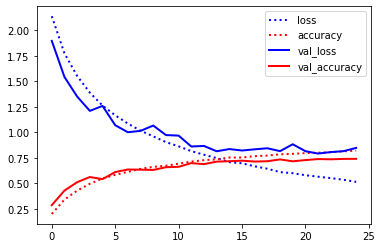
Slightly better accuracy and very little overfitting remains.
Next, we try adding Batch Normalization.
model = models.Sequential()
model.add(layers.Conv2D(32, (3, 3), activation='relu', padding='same', input_shape=(32, 32, 3)))
model.add(layers.BatchNormalization())
model.add(layers.Conv2D(32, (3, 3), activation='relu', padding='same'))
model.add(layers.BatchNormalization())
model.add(layers.MaxPooling2D((2, 2)))
model.add(layers.Dropout(0.2))
model.add(layers.Conv2D(64, (3, 3), activation='relu', padding='same'))
model.add(layers.BatchNormalization())
model.add(layers.Conv2D(64, (3, 3), activation='relu', padding='same'))
model.add(layers.BatchNormalization())
model.add(layers.MaxPooling2D((2, 2)))
model.add(layers.Dropout(0.3))
model.add(layers.Conv2D(128, (3, 3), activation='relu', padding='same'))
model.add(layers.BatchNormalization())
model.add(layers.Conv2D(128, (3, 3), activation='relu', padding='same'))
model.add(layers.BatchNormalization())
model.add(layers.MaxPooling2D((2, 2)))
model.add(layers.Dropout(0.4))
model.add(layers.Flatten())
model.add(layers.Dense(128, activation='relu'))
model.add(layers.BatchNormalization())
model.add(layers.Dropout(0.5))
model.add(layers.Dense(10, activation='softmax'))
model.compile(optimizer='rmsprop',
loss='categorical_crossentropy',
metrics=['accuracy'])
history = model.fit(X_train, y_train, epochs=25, batch_size=64, verbose=0,
validation_data=(X_test, y_test))
pd.DataFrame(history.history).plot(lw=2,style=['b:','r:','b-','r-']);
print("Max val_acc",np.max(history.history['val_accuracy']))
Max val_acc 0.7827500104904175
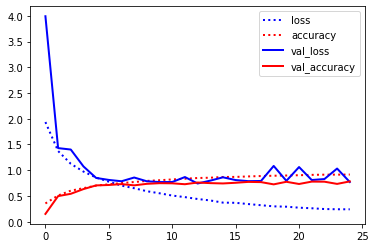
Exercise 4: Data Augmentation#
Perform image augmentation. You can use the ImageDataGenerator for this.
What is the effect? What is the effect with and without Dropout?
Plot and interpret the learning curves
from tensorflow.keras.preprocessing.image import ImageDataGenerator
train_datagen = ImageDataGenerator(
width_shift_range=0.1,
height_shift_range=0.1,
horizontal_flip=True,)
it_train = train_datagen.flow(X_train, y_train, batch_size=64)
from tensorflow.keras import layers
from tensorflow.keras import models
model = models.Sequential()
model.add(layers.Conv2D(32, (3, 3), activation='relu', padding='same', input_shape=(32, 32, 3)))
model.add(layers.BatchNormalization())
model.add(layers.Conv2D(32, (3, 3), activation='relu', padding='same'))
model.add(layers.BatchNormalization())
model.add(layers.MaxPooling2D((2, 2)))
model.add(layers.Dropout(0.2))
model.add(layers.Conv2D(64, (3, 3), activation='relu', padding='same'))
model.add(layers.BatchNormalization())
model.add(layers.Conv2D(64, (3, 3), activation='relu', padding='same'))
model.add(layers.BatchNormalization())
model.add(layers.MaxPooling2D((2, 2)))
model.add(layers.Dropout(0.3))
model.add(layers.Conv2D(128, (3, 3), activation='relu', padding='same'))
model.add(layers.BatchNormalization())
model.add(layers.Conv2D(128, (3, 3), activation='relu', padding='same'))
model.add(layers.BatchNormalization())
model.add(layers.MaxPooling2D((2, 2)))
model.add(layers.Dropout(0.4))
model.add(layers.Flatten())
model.add(layers.Dense(128, activation='relu'))
model.add(layers.BatchNormalization())
model.add(layers.Dropout(0.5))
model.add(layers.Dense(10, activation='softmax'))
model.compile(optimizer='rmsprop',
loss='categorical_crossentropy',
metrics=['accuracy'])
steps = int(X_train.shape[0] / 64)
history = model.fit(it_train, epochs=25, steps_per_epoch=steps, verbose=0,
validation_data=(X_test, y_test))
import pandas as pd
import numpy as np
pd.DataFrame(history.history).plot(lw=2,style=['b:','r:','b-','r-']);
print("Max val_acc",np.max(history.history['val_accuracy']))
Max val_acc 0.8022500276565552
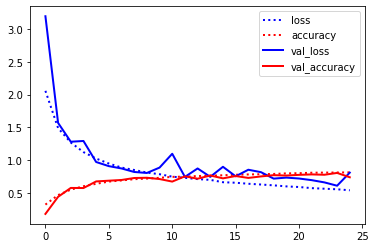
We get 2-3% improvement. We get the best results with very subtle data augmentation (small shifts and flips). The images are quite low resolution and rotation or sheer will destroy too much information.
Exercise 5: Interpreting misclassifications#
Chances are that even your best models are not yet perfect. It is important to understand what kind of errors it still makes.
Run the test images through the network and detect all misclassified ones
Interpret the results. Are these misclassifications to be expected?
Compute the confusion matrix. Which classes are often confused?
y_pred = model.predict(X_test)
misclassified_samples = np.nonzero(np.argmax(y_test, axis=1) != np.argmax(y_pred, axis=1))[0]
Since we have numeric outputs (a value per class), we need to take the class with the maximum value as the predicted class.
# Visualize the (first five) misclassifications, together with the predicted and actual class
fig, axes = plt.subplots(1, 5, figsize=(10, 5))
for nr, i in enumerate(misclassified_samples[:5]):
axes[nr].imshow(X_test[i])
axes[nr].set_xlabel("Predicted: %s,\n Actual : %s" % (cifar_classes[np.argmax(y_pred[i])],cifar_classes[np.argmax(y_test[i])]))
axes[nr].set_xticks(()), axes[nr].set_yticks(())
plt.show();

Some of these are indeed hard to categorize, although we can probably still improve the model quite a bit.
from sklearn.metrics import confusion_matrix
cm = confusion_matrix(np.argmax(y_test, axis=1),np.argmax(y_pred, axis=1))
fig, ax = plt.subplots()
im = ax.imshow(cm)
ax.set_xticks(np.arange(10)), ax.set_yticks(np.arange(10))
ax.set_xticklabels(list(cifar_classes.values()), rotation=45, ha="right")
ax.set_yticklabels(list(cifar_classes.values()))
ax.set_ylabel('True')
ax.set_xlabel('Predicted')
for i in range(100):
ax.text(int(i/10),i%10,cm[i%10,int(i/10)], ha="center", va="center", color="w")
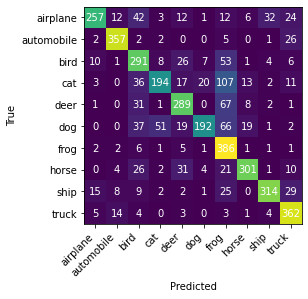
Most misclassifications seem to involve cats, birds, and horses. The most common misclassification is between cats and dogs.
Exercise 6: Interpreting the model#
Retrain your best model on all the data. Next, retrieve and visualize the activations (feature maps) for every filter for every layer, or at least for a few filters for every layer. Tip: see the course notebooks for examples on how to do this.
Interpret the results. Is your model indeed learning something useful?
model.summary()
Model: "sequential_5"
_________________________________________________________________
Layer (type) Output Shape Param #
=================================================================
conv2d_27 (Conv2D) (None, 32, 32, 32) 896
batch_normalization_7 (Batc (None, 32, 32, 32) 128
hNormalization)
conv2d_28 (Conv2D) (None, 32, 32, 32) 9248
batch_normalization_8 (Batc (None, 32, 32, 32) 128
hNormalization)
max_pooling2d_14 (MaxPoolin (None, 16, 16, 32) 0
g2D)
dropout_12 (Dropout) (None, 16, 16, 32) 0
conv2d_29 (Conv2D) (None, 16, 16, 64) 18496
batch_normalization_9 (Batc (None, 16, 16, 64) 256
hNormalization)
conv2d_30 (Conv2D) (None, 16, 16, 64) 36928
batch_normalization_10 (Bat (None, 16, 16, 64) 256
chNormalization)
max_pooling2d_15 (MaxPoolin (None, 8, 8, 64) 0
g2D)
dropout_13 (Dropout) (None, 8, 8, 64) 0
conv2d_31 (Conv2D) (None, 8, 8, 128) 73856
batch_normalization_11 (Bat (None, 8, 8, 128) 512
chNormalization)
conv2d_32 (Conv2D) (None, 8, 8, 128) 147584
batch_normalization_12 (Bat (None, 8, 8, 128) 512
chNormalization)
max_pooling2d_16 (MaxPoolin (None, 4, 4, 128) 0
g2D)
dropout_14 (Dropout) (None, 4, 4, 128) 0
flatten_5 (Flatten) (None, 2048) 0
dense_10 (Dense) (None, 128) 262272
batch_normalization_13 (Bat (None, 128) 512
chNormalization)
dropout_15 (Dropout) (None, 128) 0
dense_11 (Dense) (None, 10) 1290
=================================================================
Total params: 552,874
Trainable params: 551,722
Non-trainable params: 1,152
_________________________________________________________________
from tensorflow.keras import models
img_tensor = X_test[4]
img_tensor = np.expand_dims(img_tensor, axis=0)
# Extracts the outputs of the top 8 layers:
layer_outputs = [layer.output for layer in model.layers[:15]]
# Creates a model that will return these outputs, given the model input:
activation_model = models.Model(inputs=model.input, outputs=layer_outputs)
# This will return a list of 5 Numpy arrays:
# one array per layer activation
activations = activation_model.predict(img_tensor)
plt.rcParams['figure.dpi'] = 120
first_layer_activation = activations[0]
f, (ax1, ax2) = plt.subplots(1, 2, sharey=True)
ax1.imshow(img_tensor[0])
ax2.matshow(first_layer_activation[0, :, :, 2], cmap='viridis')
ax1.set_xticks([])
ax1.set_yticks([])
ax2.set_xticks([])
ax2.set_yticks([])
ax1.set_xlabel('Input image')
ax2.set_xlabel('Activation of filter 2');
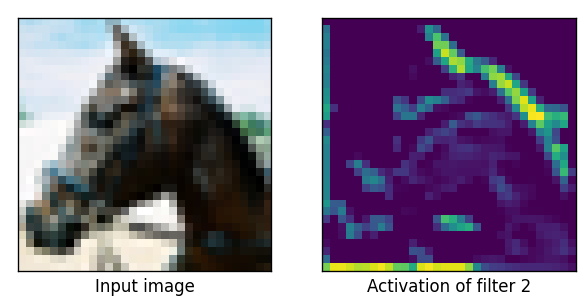
images_per_row = 16
layer_names = []
for layer in model.layers[:15]:
layer_names.append(layer.name)
def plot_activations(layer_index, activations):
start = layer_index
end = layer_index+1
# Now let's display our feature maps
for layer_name, layer_activation in zip(layer_names[start:end], activations[start:end]):
# This is the number of features in the feature map
n_features = layer_activation.shape[-1]
# The feature map has shape (1, size, size, n_features)
size = layer_activation.shape[1]
# We will tile the activation channels in this matrix
n_cols = n_features // images_per_row
display_grid = np.zeros((size * n_cols, images_per_row * size))
# We'll tile each filter into this big horizontal grid
for col in range(n_cols):
for row in range(images_per_row):
channel_image = layer_activation[0,
:, :,
col * images_per_row + row]
# Post-process the feature to make it visually palatable
channel_image -= channel_image.mean()
channel_image /= channel_image.std()
channel_image *= 64
channel_image += 128
channel_image = np.clip(channel_image, 0, 255).astype('uint8')
display_grid[col * size : (col + 1) * size,
row * size : (row + 1) * size] = channel_image
# Display the grid
scale = 1. / size
plt.figure(figsize=(scale * display_grid.shape[1],
scale * display_grid.shape[0]))
plt.title("Activation of layer {} ({})".format(layer_index+1,layer_name))
plt.grid(False)
plt.imshow(display_grid, aspect='auto', cmap='viridis')
plt.show()
plot_activations(0, activations);
/var/folders/0t/5d8ttqzd773fy0wq3h5db0xr0000gn/T/ipykernel_34025/2702396986.py:30: RuntimeWarning: invalid value encountered in true_divide
channel_image /= channel_image.std()

plot_activations(2, activations);

plot_activations(6, activations);

plot_activations(8, activations)

plot_activations(12, activations)
/var/folders/0t/5d8ttqzd773fy0wq3h5db0xr0000gn/T/ipykernel_34025/2702396986.py:30: RuntimeWarning: invalid value encountered in true_divide
channel_image /= channel_image.std()
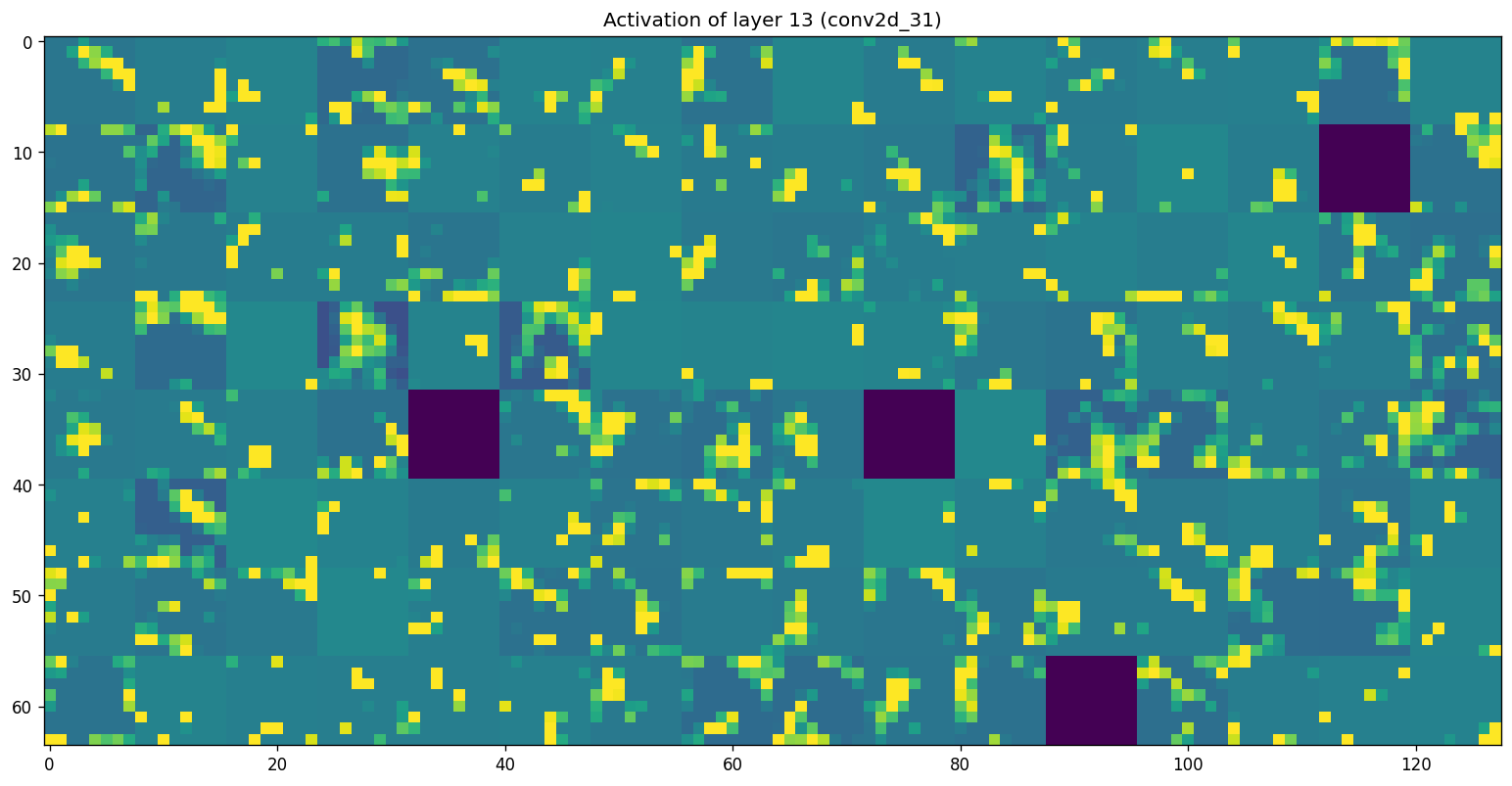
Optional: Take it a step further#
Repeat the exercises, but now use a higher-resolution version of the CIFAR dataset (with OpenML ID 41103), or another version with 100 classes (with OpenML ID 41983). Good luck!

